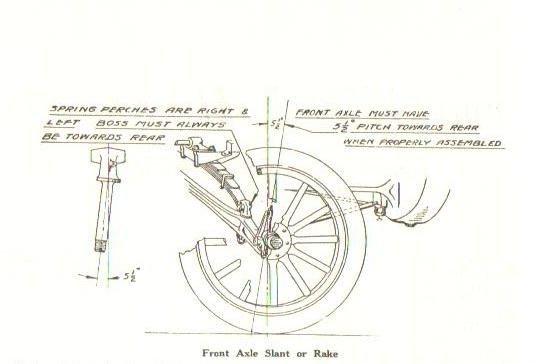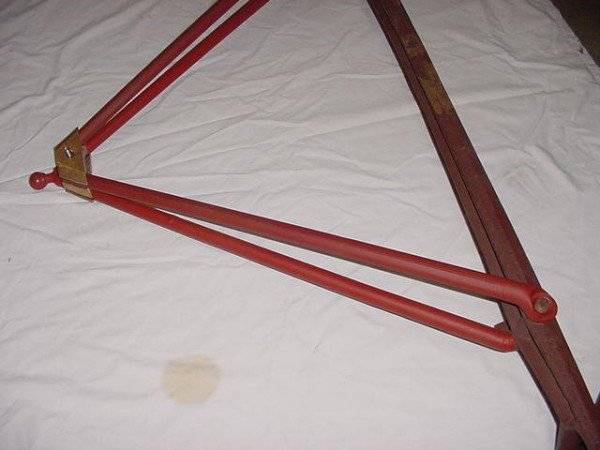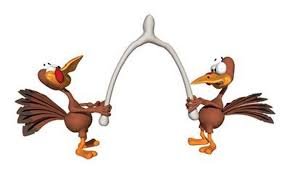Page 1 of 1
EARLY WISHBONES
Posted: Sun Nov 15, 2020 11:30 am
by John Warren
The early wishbones were prone to bending. My neighbor has just purchased a nice 15 roadster and I was telling him that there was some concern about them. One of the fixes was to install an additional modified under wishbone and tie it to the original. We were looking through the parts books and have not found anything on the fix. Please expand. Thanks.
Re: EARLY WISHBONES
Posted: Sun Nov 15, 2020 11:53 am
by tom_strickling
Re: EARLY WISHBONES
Posted: Sun Nov 15, 2020 12:23 pm
by Rich Eagle
Re: EARLY WISHBONES
Posted: Sun Nov 15, 2020 12:29 pm
by TRDxB2
I think you'll find what you want to know in this link.
http://www.mtfca.com/discus/messages/70 ... 1486606437 A picture is worth a thousand words. The front and rear suspension of the Model T is a 3-pount design that allowed them to negotiate variations in terrain (not many real roads back then) - Early models had the wishbone mounted above the axle and the later design it below the axle. Basically the under design maintains proper wheel alignment.
So several add-on accessories followed to support the early design.
Re: EARLY WISHBONES
Posted: Sun Nov 15, 2020 12:30 pm
by NealW
The 15 runabout that I restored had one of the old aftermarket wishbones attached to the bottom of the axle. When I was putting all the restored pieces back together last spring, I noticed that my front axle was not leaning back towards the rear of the car as much as it should have been. At first I thought I had installed the perches in the wrong side, but I double checked and knew that I had not made a mistake.
After that, I reinstalled the aftermarket bottom wishbone and then the axle had the proper 5 1/2 degree pitch towards the rear like the picture shows below. The later T's had the single wishbone attached to the bottom of the axle as Frank mentioned.

- axle pitch.jpg (23.6 KiB) Viewed 4644 times
Re: EARLY WISHBONES
Posted: Sun Nov 15, 2020 12:42 pm
by Oldav8tor
Part of the problem with a top mounted wishbone is that under some driving conditiions the axle can move in such a way as to render the car difficult to control. After Ford himself was involved in an accident (not too far from where I live) the wishbone was redesigned to attach to the bottom of the front axle starting I believe in 1919.
I added a second wishbone to my 1917 using parts I bought from <
https://www.ebay.com/str/antiquetmotorsportsllc> He sells a dual wishbone clamp and the later style wishbone ends. You provide the rods.

- Auxiliary wishbone viewed with axle upside down
Re: EARLY WISHBONES
Posted: Sun Nov 15, 2020 12:53 pm
by John Warren
Great thanks.
Re: EARLY WISHBONES
Posted: Sun Nov 15, 2020 1:20 pm
by Retro54
My 1915 front end has a unique solution. The spring perches are replaced with accessory posts that fit into the old perch holes on the axle and place the wishbone below the axle. The spring is then lengthened with accessory leafs and clamped to the axke ends with cast pieces..
The original issue wasn't with bones breaking, but with incorrect axle geometry with the wishbone being placed above the axle. Either doubling them up or moving the wishbone to below the axle corrects this geometry issue.
Re: EARLY WISHBONES
Posted: Sun Nov 15, 2020 2:00 pm
by aDave
John,
I had the same situation with my '15 Touring. Unfortunately, the local fix was to install a second "under the axle" wishbone...which does work, but the standard perch is not long enough to allow the castellated nut to screw onto the perch far enough to use the NECESSARY cotter pins.
Sure, once can grind off some "meat" off the ends of the wishbone, but the resulting thinness of the metal made me a tad uncomfortable.
My solution was to purchase this:
https://www.modeltford.com/item/2733S.aspx
I am happy with it.
Dave
Re: EARLY WISHBONES
Posted: Sun Nov 15, 2020 2:08 pm
by GEmering
Not to hijack this thread....
Looks like my ‘13 has the additional wishbone support?
Gene
Re: EARLY WISHBONES
Posted: Sun Nov 15, 2020 2:42 pm
by Bud Delong
A well told story of the accident is in Tin Lizzie by Stern!! Well worth the read!! Bud.

Re: EARLY WISHBONES
Posted: Sun Nov 15, 2020 3:21 pm
by George House
What oldav8tor said on 15 Nov. that hunk of brass + cut down later under axle wishbone is the BEST
Re: EARLY WISHBONES
Posted: Sun Nov 15, 2020 4:09 pm
by ThreePedalTapDancer
Re: EARLY WISHBONES
Posted: Sun Nov 15, 2020 5:34 pm
by Original Smith
Ford did sort of take care of the problem before the new style. I have one in one of my '13s. They beefed them up so they were bigger and stronger.
Re: EARLY WISHBONES
Posted: Sun Nov 15, 2020 7:09 pm
by Michael Peternell
I get why the geometry of the wishbone on top is a bad design. Just asking if there are any recent examples of failure's on our modern day roads? In the day roads were a bit different. Just asking.
Re: EARLY WISHBONES
Posted: Mon Nov 16, 2020 10:07 am
by TWrenn
Michael, I have the over the axle wishbone of course on my '13. Never (knock on wood) any problems. As I explained to Gene over the phone just this morning, I always "look ahead" on my roads for anything unusual or dangerous, and especially on approach and leaving bridges, they always seem to have a bump before and after, as well as the expansion joints. That said, I just slow up a bit, and hang on a bit tighter "just in case". But thankfully never any problem. I think a lot of the early day issues of course were with the rutted roads grabbing the wheels in such a manner so as to "pull" the axle underwards (if that's a word!). We just don't thankfully have that much of a concern. If on a dirt or stone road of course with many ruts/potholes that would be a different story. Then I would definitely add an accessory uder-the-axle wishbone.
Re: EARLY WISHBONES
Posted: Mon Nov 16, 2020 11:05 am
by John Warren
You guys are the best! Just put it out there and WALA things are explained. I knew there was a problem just didn't know exactly what it was. I do like adding the modified second wishbone under the axle and now with the clamp available it looks like it will be a fairly easy mod. Thank you all for your input.

Re: EARLY WISHBONES
Posted: Mon Nov 16, 2020 12:57 pm
by perry kete
Here is another early wishbone!

- turkey.jpg (6.82 KiB) Viewed 4249 times
Re: EARLY WISHBONES
Posted: Mon Nov 16, 2020 4:15 pm
by Jerry VanOoteghem
Michael Peternell wrote: ↑Sun Nov 15, 2020 7:09 pm
I get why the geometry of the wishbone on top is a bad design. Just asking if there are any recent examples of failure's on our modern day roads? In the day roads were a bit different. Just asking.
Michael,
I test drove my friend's 1914 just after he bought it. Seemed fine until I made a left hand turn. Both front wheels swung hard to the left, nearly causing me to hit a stopped car. If I hadn't been on my guard to begin with, it would have been a collision. When we got back to my friend's house, I looked over the front end. All looked fine. Then I turned the wheels left again, with the car standing still, and saw the whole front axle roll forward. It actually was as if it were wanting to roll under the car. It caused the caster angle to go from normal to maybe 15 degrees the wrong way, (i.e. forward).
Turned out, the studs at the ends of the wishbone, along with the holes in the perches, were completely worn out and sloppy loose. The axle didn't just move by the amount of the excess clearance however. The arms of the wishbone actually rotated torsionally as the axle rolled forward. Hard to describe, but freaky to watch and scary to drive! So yes, it was largely a matter of totally worn out parts, but it also demonstrated the dynamics of what occurs when the wishbone fails. I don't believe that they just bend or break, (though I'm sure that some do). I believe that even a wishbone in good condition can rotate in the perches and twist, allowing the axle to "go under", when an out-of-the-ordinary force is applied. It was a convincing demonstration. That car now has an excellent wishbone, nos perches, and an under-axle brace.
Re: EARLY WISHBONES
Posted: Mon Nov 16, 2020 4:57 pm
by Oldav8tor
I believe Henry Ford's accident occurred when he hit a patch of sand while traveling at high speed. The car became uncontrollable and he was thrown from the vehicle along with one of his engineers. Fortunately no serious injuries but the car was damaged enough to be undriveable until repaired.
The way I dealt with the castle nut was to grind a taper on the non-castellated edge and a matching taper into the eyelet. I also used a small round file to round the bottom edges of the castellations. It snugs up quite nicely and allows the all-important cotter pin. I've checked it periodically over the last 3000 miles and all is snug.
Other designs use a flat piece of steel so I suspect you either have to use a thinner castle nut (available from aircraft hardware suppliers) or grind a little off the nut or castellations.
Re: EARLY WISHBONES
Posted: Mon Nov 16, 2020 5:24 pm
by Wayne Sheldon
The early style wishbone was generally fine for the normal speeds of the day. Henry Ford's famous crash was due to excessive speed, and likely a pothole or rut that triggered the accident. Today our better roads are both a blessing and a curse upon the early model Ts. A blessing in that we can go faster and on smoother roads with less abuse to the car. A curse because something they didn't allow for in the early design. If everything in the front axle assembly is in good condition, and properly tight and adjusted? They generally work just fine. HOWEVER, There is a silly thing called "harmonic vibration" that can rear its ugly head under certain difficult to predict circumstances. At just the wrong speed, with just a bit of stress from a slight turn or variation in road surface, the front axle assembly can go instantly into a sort of "death wobble" . Even the best most solid original early wishbone springs and perches have enough flex that the wobble can and will with that harmonic vibration pushing it to extremes, cause the front axle caster to go the wrong way, and cause a sudden steering push full over. These harmonics come up very quickly, and unless someone is personally familiar with such phenomenon, won't be recognized even if they do give minor warnings. For most people, the first hint of a potential problem is the one time it goes berserk.
Over the past fifteen years, I believe there have been three deaths of longtime model T people discussed on this forum that were due to front end collapse under circumstances that suggest a harmonic vibration was involved.
Sound advice? As others have said, an added brace to under the axle changes the dynamics a great deal in your favor.
Re: EARLY WISHBONES
Posted: Mon Nov 16, 2020 8:02 pm
by Jerry VanOoteghem
Oldav8tor wrote: ↑Mon Nov 16, 2020 4:57 pm
The way I dealt with the castle nut was to grind a taper on the non-castellated edge and a matching taper into the eyelet. I also used a small round file to round the bottom edges of the castellations. It snugs up quite nicely and allows the all-important cotter pin. I've checked it periodically over the last 3000 miles and all is snug.
Tim,
That's exactly the same thing I did!
Re: EARLY WISHBONES
Posted: Mon Nov 16, 2020 8:44 pm
by Oldav8tor
Jerry - the fact that you did the same thing tells me I'm in good company

I should have added that the holes in the eyelets were a little larger than the threaded end of the perch so the combination of tapers did a good job of centering the end of the wishbone and holding it firmly.
Re: EARLY WISHBONES
Posted: Mon Nov 16, 2020 9:08 pm
by Oldav8tor
Found this, enjoy!
Henry Ford and the Reason for the Radius Rod Upgrade
In the summer of 1914, I was walking across the Highland Park Garage. There were two cars standing in there. Mr. Ford waved to me and said, "Joe, get in here!" I didn't have any hat or coat on, but I got into the car, and I didn't get back to Detroit for three days. When we started out, I didn't know where we were going.
We landed up in North Harbor Beach. Mr. Ford had a log cabin at Harbor Beach. Before we got up to the cottage, Mr. Ford stopped at the grocery store and bought some bacon, eggs and went over to a fish place where he got some fresh codfish. He bought a dozen or so perch and we then went out to his log cabin.
We stayed there for three days before we went back. The roads in those days were not very good. They were not gravel, but sand. Mr. Ford seemed to want to drive faster going home than he did coming up. He told the driver to step on it. When the driver wouldn't go fast enough, he would grab the old Model T throttle so that the car was wide open.
I was about a hundred feet behind Mr. Ford and Frank Kulick. We came to a hill, and I thought his car was going too fast for a car in that sandy road. All at once, I saw the car going end for end, and Mr. Ford was dumped out in the ditch. Frank jumped out. He [Mr. Ford] didn't get hurt other than a scratch on his face, but he was dazed a little bit. It is a wonder he didn't break his neck.
Two of the boys went up to Maryland to get a new front unit. I stayed with Mr. Ford. They came back and changed the front axle. We found out that when the car hit that sand the front wheels had buckled. We drove back to Detroit.
We were late, and Mrs. Ford was worried about us and wondered what happened. I heard later that Mr. Ford never told her what happened. It was all kept very quiet. Nobody knew anything about it right up to the time Mr. Ford died. I said to myself, "There is one thing we have to got to do and that is fix that radius rod." I made up a radius rod, which was holding the axle top and bottom, and made it about two and a half inches near the axle, all the man would have to buy was a new radius rod and a spring perch which supports the front spring.
I made about two dozen of these and put them out on the farm to make tests. I told Ray Dallinger to try to do everything he could do. "Drive in the sand head first. Drive into the bank and see what you can do with it." He could do anything with it and couldn't even bend it.
Mr. Ford found out about two months later. I think somebody must have told him that Joe [Galamb] had a radius rod he couldn't bend. If I had told Mr. Ford about it when I first started to build it, it would have been alright. All Mr. Ford would let me do was increase the wall of the tubing so that the front end was larger, and people wouldn't see that there was any change. That just shows how stubborn he was. He was practically killed with the old rod, but he still didn't want it changed.
Note: It was changed in the 1919 model year when the old stock was used up. There is some question about the dates mentioned in this story but since no one is left who was involved in the change it is the best we have.
The road mentioned is now M25, which runs along the Lake Huron shoreline. It wasn't paved until the 1940's and had many sandy sections.